This page applies to Apigee and Apigee hybrid.
View
Apigee Edge documentation.
![]()
Apigee Emulator lets you simulate an Apigee installation in your local development environment, for testing purposes. Apigee Emulator does not replace an Apigee installation for testing and does not have identical functionality, but simplifies testing from within the local development environment.
Apigee Emulator is available as a customized Docker image provided publicly to developers to deploy and test API proxies in a local development environment. Docker images are published regularly in gcr.
When you are ready to deploy and test your first API proxy, you will need to use the emulators section to view and manage your emulator versions and the lifecycle of the emulators that are set up.
This section lets you:
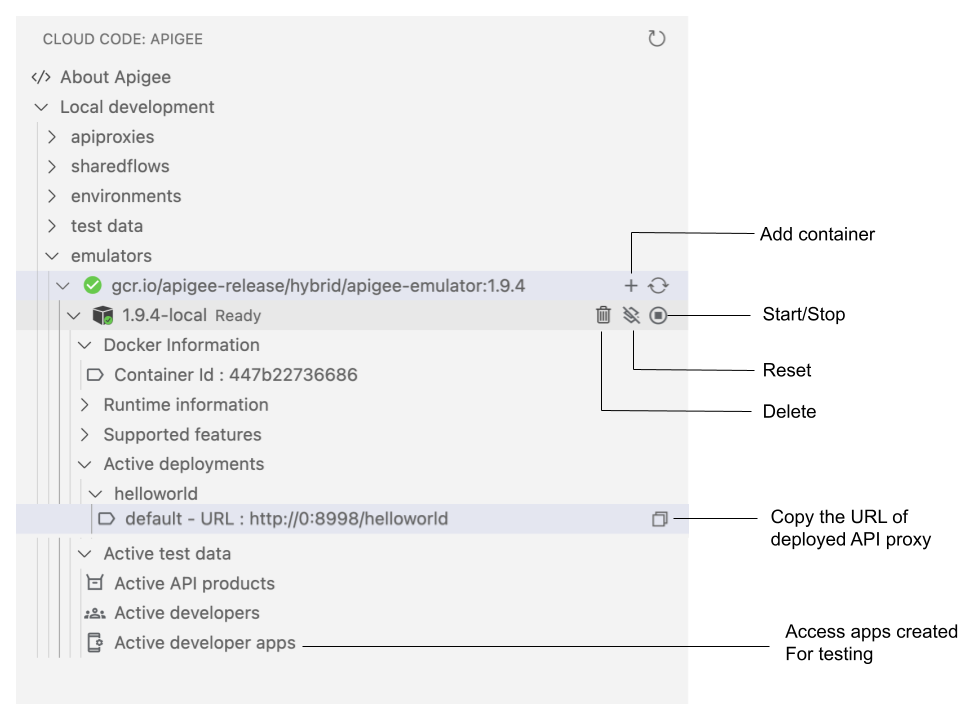
View the different versions of the emulators that are installed, and the containers created for each emulator version, including its Docker and runtime information, and control and traffic ports.
Add, delete, start, stop, reset, update, and refresh the view of the Apigee Emulator containers, as described in Managing the Apigee Emulator.
View deployed applications (see Deploying environments).
View active test resources (see Exporting test resources to the Apigee Emulator).
Managing the Apigee Emulator
Manage the Apigee Emulator as described in the following sections.
Choosing the emulator version
By default, the emulator folder shows a version which is stable. However, you can choose a different version based on your requirements.
View a list of Apigee Emulator versions in Google Artifact Registry and note the Tag value. For more information, see the Artifact Registry documentation.
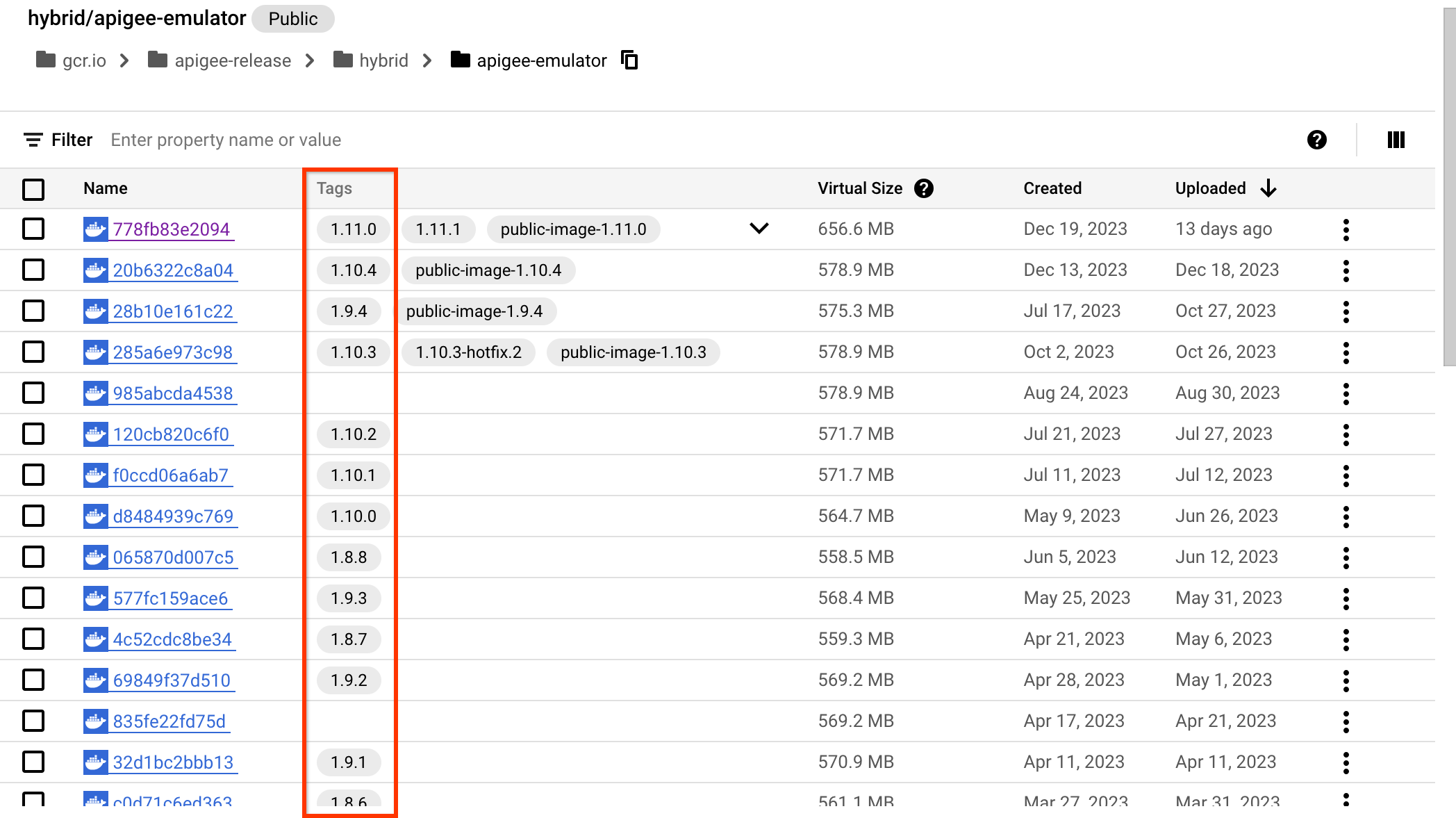
To add an Apigee Emulator version to the Cloud Code extension, click Manage > Settings and then search for
apigee emulators.Click Add item.
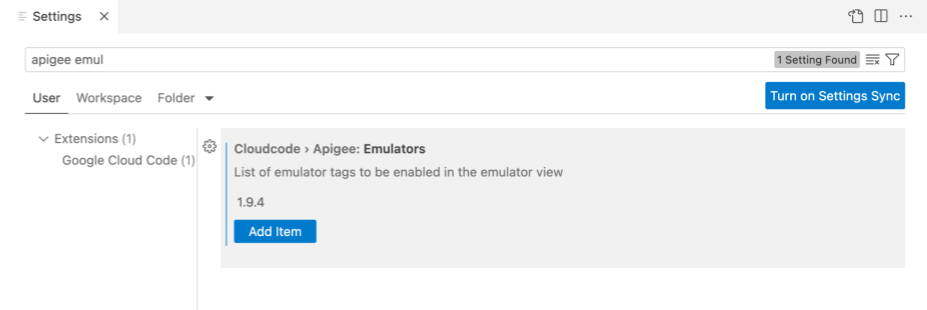
Enter the Tag value obtained in step 1. For example:
1.10.0orgcr.io/apigee-release/hybrid/apigee-emulator:1.10.0Click OK.
The newly added emulator shows in the emulator folder.
Installing the Apigee Emulator
To install the Apigee Emulator:
Expand the emulators folder in your workspace.
Position your cursor over the Apigee Emulator version to install.
Click
 .
.
Add a container following the instructions in Adding a container for the Apigee
Emulator.
The latest image of the selected Apigee Emulator version is installed. After the
installation completes, the message Emulator installed successfully displays,
and the Apigee Emulator container status changes to Ready.

Adding a container for the Apigee Emulator
To add a container for the Apigee Emulator using the UI:
Expand the emulators folder.
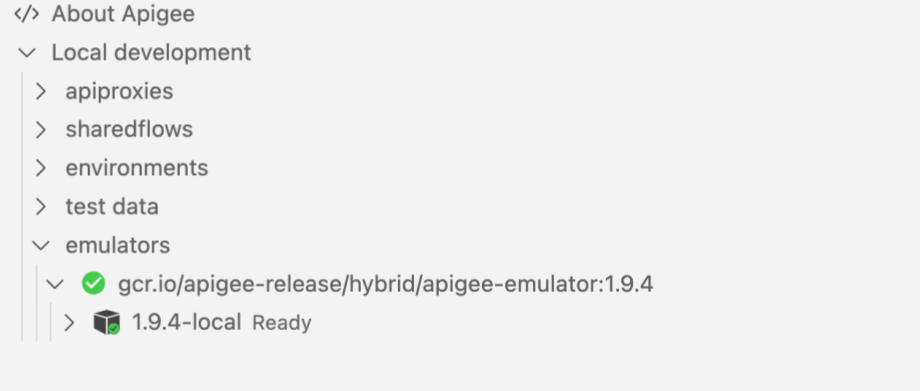
Position your cursor over the Apigee Emulator for which you want to add a container.
Click +.
Enter a unique name for the Apigee Emulator container and press Enter. Enter alphanumeric characters, dashes (-), or underscores (_).
Enter the numeric value to use as the control port for the Apigee Emulator container and press Enter. The control port must be unique across containers. It defaults to
8080.Enter the numeric value to use as the traffic port for the Apigee Emulator container and press Enter. The traffic port must be unique across containers. It defaults to
8998.
The container is added.
Viewing status information for the Apigee Emulator
View status information for the Apigee Emulator as described in the following sections.
Using the UI
To view status information for the Apigee Emulator, including its Docker and Runtime information, expand the container in the emulators section. The information you see matches the Apigee Emulator version in use.
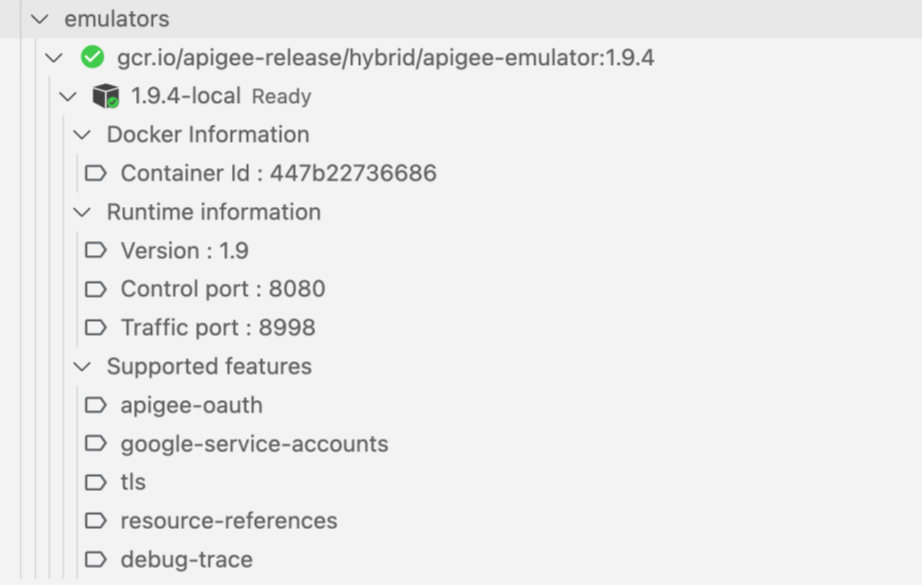
Using the Docker CLI
To view container status information for the Apigee Emulator and its configured
ports, run docker ps in the Terminal tab. The following
provides an example response. The actual response you see depends on the Apigee
Emulator version in use:
CONTAINER ID IMAGE COMMAND CREATED STATUS PORTS NAMES 33756b8c5c5b ...apigee-emulator:1.11.0 "/usr/bin…" 10 hours ago Up 10 hours 7000-7001/tcp, 0.0.0.0:8080->8080/tcp... apigee-emulator
See also Customizing the Apigee runtime Docker container.
Starting the Apigee Emulator
Start the Apigee Emulator as described in the following sections.
Using the UI
To start the Apigee Emulator, position your cursor over the container that you
want to start and click ![]() .
.
Using the Docker CLI
To start the Apigee Emulator, run docker start CONTAINER_NAME
in the Terminal tab.
The status is set to Ready:

See also Customizing the Apigee runtime Docker container.
Resetting the Apigee Emulator
Reset the Apigee Emulator to remove all deployments and exported test resources as described in the following sections.
Using the UI
To reset the Apigee Emulator, position your cursor over the Apigee Emulator
container in the emulators section and click ![]() .
.
The Apigee Emulator is reset and the status is set to Ready:

The following information is displayed in the Output tab:
Resetting the Apigee Emulator Reset completed
See also Customizing the Apigee runtime Docker container.
Restarting the Apigee Emulator
To restart the Apigee Emulator, run docker restart CONTAINER_NAME in the Terminal tab. For example: docker restart MyContainer
Updating the Apigee Emulator
If the Apigee Emulator is out of sync with the latest version, you can update your installed version using the UI or Docker CLI, as described in the following sections.
Using the UI
To update the Apigee Emulator, position your cursor over the Apigee Emulator in
the emulators section and click
![]() .
.
Using the Docker CLI
To update the Apigee Emulator, run the following Docker commands in the Terminal tab, using the latest appropriate version:
Run
docker psto obtain the image name. Example:gcr.io/apigee-release/hybrid/apigee-emulator:EMULATOR_VERSIONRun
docker pull IMAGE_NAMEto update the Apigee Emulator installation image. Example:docker pull gcr.io/apigee-release/hybrid/apigee-emulator:EMULATOR_VERSION
The Apigee Emulator is updated and the following message is displayed: Emulator version is up to date
See also Customizing the Apigee runtime Docker container.
Stopping the Apigee Emulator
Stop the Apigee Emulator using the UI or Docker CLI as described in the following sections.
Using the UI
To stop the Apigee Emulator, position your cursor over the Apigee Emulator
container in the emulators section and click ![]() .
.
Using the Docker CLI
To stop the Apigee Emulator, run docker stop CONTAINER_NAME in the Terminal tab.
The Apigee Emulator is stopped and the status is changed to
Not
running:

See also Customizing the Apigee runtime Docker container.
Deleting a container for the Apigee Emulator
Delete a container for the Apigee Emulator using the UI or Docker CL as described in the following sections.
Using the UI
To delete the Apigee Emulator, position your cursor over the Apigee Emulator
container in the emulators section and click ![]() .
.
Using the Docker CLI
To delete a container for the Apigee Emulator, run the following Docker commands in the Terminal tab:
Run
docker stop CONTAINER_NAMEto stop the Apigee Emulator installation image (if it's not already stopped). For example:docker stop MyContainerRun
docker rm CONTAINER_NAMEto stop the Apigee Emulator installation image. For example:docker rm MyContainer
The container is deleted.
See also Customizing the Apigee runtime Docker container.
Customizing the Apigee runtime Docker container
You can customize the Docker command line that is used to control the Apigee Emulator instances by using the following options.
| Option | Description |
|---|---|
additionalArguments |
Add one or more arguments. The arguments are added to the docker run command exactly as provided. Defaults to "" (none). |
detached |
Controls whether the --detached option is used while running the container. Defaults to true. |
dns |
Controls the DNS service -dns flag, as described in DNS services. Defaults to 8.8.8.8.
|
environmentVariables |
Add environment variables to the docker run command, as described in Options. The values, if provided, are added to the docker run command using -e . Default list includes "XTERM": "xterm-256color".
|
labels |
Add one or more labels to be attached with the container. The labels are added to the docker run command using -l . Defaults to none. |
privileged |
Controls whether --privileged option is used while running the container. Defaults to true. |
volumes |
Add one or more volumes to be mounted on the container. The volumes are added to the docker run command using -v . Defaults to none. |
To customize the Apigee runtime Docker container:
This feature is available as part of the Insiders build (v1.21.0 and higher). Install the Insiders build, as described in Installing Insiders builds.
Click Manage > Settings and then search for
apigee docker.Under Cloudcode > Apigee: Docker Options, click Edit in settings.json. The customizable options are displayed in the
settings.jsonfile, as shown:"cloudcode.apigee.dockerOptions": { "environmentVariables": { "XTERM": "xterm-256-color" }, "dns": "8.8.8.8", "detached": true "privileged": true, "labels": {}, "volumes": {}, "additionalArguments":"" }Edit the options and save the file.
Customizing the Apigee Emulator to support service account-based authentication
When testing the proxies that depend on Google Cloud service account-based authentication, Apigee Emulator needs access to the Google service account key. Follow the steps to configure your Apigee Emulator to support service account-based authentication.
Creating and downloading the service account key
Create a Google Cloud service account with the Service Account Token Creator role, which is a requirement for the Apigee Emulator to support service accounts. Create a key for the service account, as described in Create a service account key.
Download the key to the local file system, so that it can be provided to the Apigee emulator.
Configuring the Apigee Emulator
To configure the Apigee Emulator settings:
Open the Docker options, as described in Customizing the Apigee runtime Docker
container.
In the
volumessection of the Docker options, add a new volume so that the downloaded service account key path is available in the container. Assuming the key was downloaded in the path/opt/apigee/keys/apigee-sa-key.json, the following setting mounts the contents of/opt/apigee/keysin the path/emulator/keyswithin the container:"volumes": { "/opt/apigee/keys":"/emulator/keys" }In the
environmentVariablessection of the Docker options, add theGOOGLE_APPLICATION_CREDENTIALSvariable that points to the file in the mounted path:"environmentVariables": { "GOOGLE_APPLICATION_CREDENTIALS":"/emulator/keys/apigee-sa-key.json" }Save the settings and create a new container instance which can be used for testing.
The following example shows how to associate a Google service account key with the Apigee Emulator.
"cloudcode.apigee.dockerOptions": {
"environmentVariables": {
"XTERM": "xterm-256-color",
"GOOGLE_APPLICATION_CREDENTIALS":"/emulator/keys/apigee-sa-key.json"
},
"dns": "8.8.8.8",
"detached": true
"privileged": true,
"labels": {},
"volumes": {
"/opt/apigee/keys":"/emulator/keys"
},
"additionalArguments":""
}Configuring the Apigee Emulator to support HTTP forward proxy
Many times the backend targets associated with a proxy can only be reached using
an HTTP forward proxy. The Apigee emulator can be configured to use the forward
proxy while connecting to targets using an environment variable named
FORWARD_PROXY.
To configure the Apigee Emulator settings:
Open the Docker options, as described in Customizing the Apigee runtime Docker container.
In the
environmentVariablessection of the Docker options, add theFORWARD_PROXYvariable that points to the forward proxy address as an HTTP URL"environmentVariables": { "FORWARD_PROXY":"http://proxy_host:proxy_port" }Save the settings and create a new container instance for testing.
